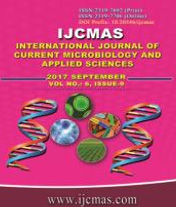


 National Academy of Agricultural Sciences (NAAS)
National Academy of Agricultural Sciences (NAAS)

|
PRINT ISSN : 2319-7692
Online ISSN : 2319-7706 Issues : 12 per year Publisher : Excellent Publishers Email : editorijcmas@gmail.com / submit@ijcmas.com Editor-in-chief: Dr.M.Prakash Index Copernicus ICV 2018: 95.39 NAAS RATING 2020: 5.38 |
Remote sensing and GIS techniques were used to delineate and characterize the Purvi Nayyar river watershed in Pauri Garhwal district of Uttarakhand, India pertaining to warm humid Himalayan ecosystem. Based on image characteristics and ground truth studies, four major physiographies viz., hill/ridge tops, side/reposed slopes, valleys and escarpments were delineated. They were further subdivided into ten physiographic units based on slopes and integrated with land use systems to delineate physiographic land units (PLU). Ten soils were identified occurring on different PLUs. Major soils occur on hill/ridge tops and side/reposed slopes and are very shallow to moderately shallow in depth, excessively drained, gravelly loamy sand and coarse sandy loam in texture and single grain to massive in structure. They have only A-C horizons underlain by indurated bed rock at 11 to 81 cm depth and belong to Entisols. Soils of valleys are deep to very deep, well drained, sandy loam to sandy clay loam in texture, medium, weak and moderate subangular blocky in structure having A-B-C horizons and belong to Inceptisols. Soils are acidic in nature with low to medium cation exchange capapcity and very low to low water holding capacity. Since, the watershed area is highly prone to various kinds of degradation, suitable soil and water conservation measures have been suggested to maintain soil health and integrated development of the area.
 |
 |
 |
 |
 |